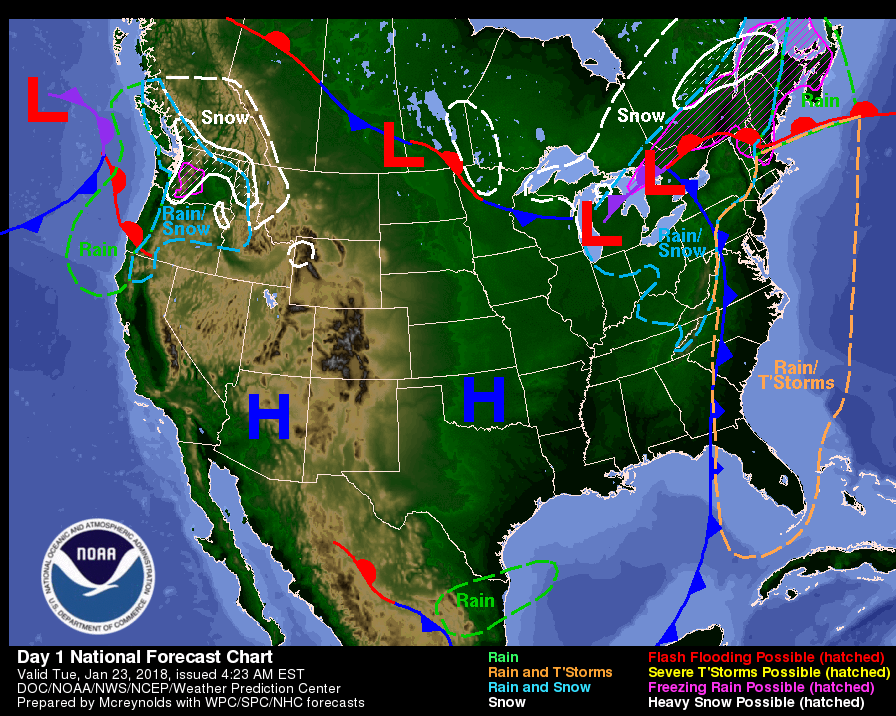What is Atmospheric Pressure?
What is Atmospheric Pressure?
Or what is barometric pressure? Atmospheric pressure is also called barometric pressure because barometers are used to measure it. Atmospheric pressure, barometric pressure, and air pressure all refer to the same thing: the weight of the atmosphere at any location, generated by the downward force of gravity. Pressure decreases with increasing elevation because there is less air above you.
High Atmospheric Pressure
When high pressure is used to describe the current weather conditions, this means there is more pressure (or weight) in that particular region. This results in the downward movement of air, so in turn, results in less weather development. Since cloud formation requires rising air, you’ll likely experience clear and sunny skies under areas of high atmospheric pressure.
Low Atmospheric Pressure
When low pressure is used to described the current weather conditions, this means there is less pressure (or weight) in that particular region. In opposition from a high pressure system, low pressure systems are accompanied by the upward movement of air which can lead to clouds and weather development.

What Causes Atmospheric Pressure Changes?
Since the weight of the air molecules above any given point is what actually causes atmospheric pressure, let’s discuss what causes changes in atmospheric pressure, or changes in barometric pressure.
If changes in pressure trigger changes in weather, what causes changes in pressure? Changes in pressure are caused by changes in density of the air, which relates to the temperature of the air. As cold air is more dense than warm air, the pressure in the cooler area will be higher than the pressure over the warmer air. This relates to the velocity of the molecules in warm air versus cold air. As daytime temperatures change, we have daily pressure changes, but we also have pressure changes that occur with larger-scale weather patterns from the global circulations that result from the Earth’s tilt and rotation around the sun! Science — it’s all connected!
How Is Air Pressure Measured?
Electronic pressure sensors used in AcuRite products and most home weather stations measure pressure changes through a device that includes a quartz membrane secured over an evacuated chamber. As this flexes with changes in pressure, it measures the strain due to an applied force over an area. The output of voltage fluctuations are then converted to digital readings to be used on home weather displays or your online apps and weather dashboards.
The Effects of Atmospheric Pressure on Weather and Health
Atmospheric pressure changes occur with large-scale high and low pressure systems moving across the Earth. High pressure generally implies clear skies and uneventful weather while low pressure generally implies clouds, precipitation, and active weather. Most home weather stations, including the AcuRite Iris™ and AcuRite Atlas®, can help you understand what weather is on the way by tracking the pressure trend. In addition to knowing about approaching weather, monitoring pressure changes at home can help you understand your joint pain and headaches or migraines. Even your hunting and fishing trips can be affected by changes in barometric pressure!
One pressure measurement alone doesn't help meteorologists understand the weather, but if we have multiple readings of increasing or decreasing pressure values, then we can have some idea of the forecast. Increasing pressure tells us higher pressure is coming and skies will clear up, while decreasing pressure signals a low pressure system is on its way bringing clouds and possibly rain.
How to Identify Atmospheric Pressure Changes
The warm and cold fronts accompanying these high and low pressure systems are what trigger rain and severe weather events. You may recognize the below image from the National Weather Service, similar to weather maps often shown by your local TV meteorologist. You will see precipitation along and ahead of the fronts associated with low pressure, while generally uneventful weather accompanies high pressure systems. Learn how to monitor and track pressure trends in your region with your own home weather station and have the added bonus of online reporting so you can access the data anywhere through the My AcuRite® app!







